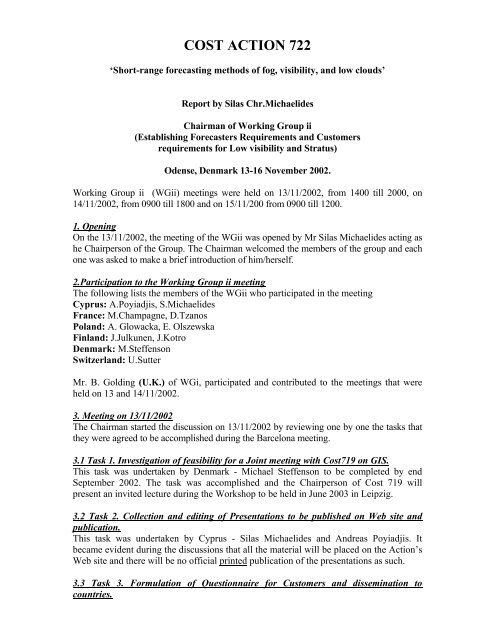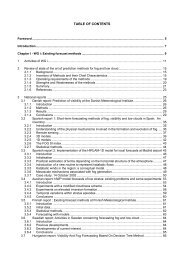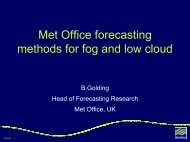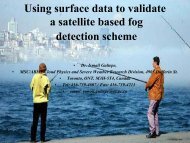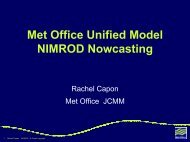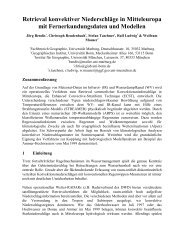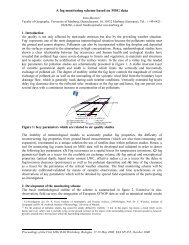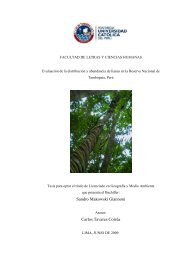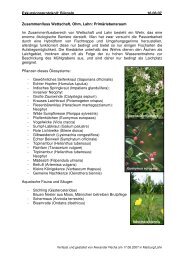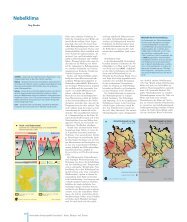Chair Report
Chair Report
Chair Report
Create successful ePaper yourself
Turn your PDF publications into a flip-book with our unique Google optimized e-Paper software.
COST ACTION 722<br />
‘Short-range forecasting methods of fog, visibility, and low clouds’<br />
<strong>Report</strong> by Silas Chr.Michaelides<br />
<strong>Chair</strong>man of Working Group ii<br />
(Establishing Forecasters Requirements and Customers<br />
requirements for Low visibility and Stratus)<br />
Odense, Denmark 13-16 November 2002.<br />
Working Group ii (WGii) meetings were held on 13/11/2002, from 1400 till 2000, on<br />
14/11/2002, from 0900 till 1800 and on 15/11/200 from 0900 till 1200.<br />
1. Opening<br />
On the 13/11/2002, the meeting of the WGii was opened by Mr Silas Michaelides acting as<br />
he <strong>Chair</strong>person of the Group. The <strong>Chair</strong>man welcomed the members of the group and each<br />
one was asked to make a brief introduction of him/herself.<br />
2.Participation to the Working Group ii meeting<br />
The following lists the members of the WGii who participated in the meeting<br />
Cyprus: A.Poyiadjis, S.Michaelides<br />
France: M.Champagne, D.Tzanos<br />
Poland: A. Glowacka, E. Olszewska<br />
Finland: J.Julkunen, J.Kotro<br />
Denmark: M.Steffenson<br />
Switzerland: U.Sutter<br />
Mr. B. Golding (U.K.) of WGi, participated and contributed to the meetings that were<br />
held on 13 and 14/11/2002.<br />
3. Meeting on 13/11/2002<br />
The <strong>Chair</strong>man started the discussion on 13/11/2002 by reviewing one by one the tasks that<br />
they were agreed to be accomplished during the Barcelona meeting.<br />
3.1 Task 1. Investigation of feasibility for a Joint meeting with Cost719 on GIS.<br />
This task was undertaken by Denmark - Michael Steffenson to be completed by end<br />
September 2002. The task was accomplished and the <strong>Chair</strong>person of Cost 719 will<br />
present an invited lecture during the Workshop to be held in June 2003 in Leipzig.<br />
3.2 Task 2. Collection and editing of Presentations to be published on Web site and<br />
publication.<br />
This task was undertaken by Cyprus - Silas Michaelides and Andreas Poyiadjis. It<br />
became evident during the discussions that all the material will be placed on the Action’s<br />
Web site and there will be no official printed publication of the presentations as such.<br />
3.3 Task 3. Formulation of Questionnaire for Customers and dissemination to<br />
countries.
This task was accomplished by Poland – A. Glowacka, E. Aszewska and M. Paradowski.<br />
By end of July 2002, the questionnaires were completed and sent to the members of the<br />
Cost Action 722, in accordance with the 2 nd MC meeting decision taken in Barcelona.<br />
The questionnaire will be placed on the Web site.<br />
3.4 Task 4. Processing and compilation of results of Questionnaire for Customers.<br />
This task was accomplished by France - Michele Champagne and by end of October 2002<br />
the results were available, as planned. A total of 24 questionnaires were processed and<br />
the results of the analysis were presented by Ms Champagne. The results will be put on<br />
the Web site, also.<br />
3.5 Task 5 Formulation of Questionnaire for Forecasters and dissemination to<br />
countries.<br />
The task was undertaken by Finland – J. Julkunen and J.Kotro. By end of July 2002 the<br />
questionnaires were completed and sent to the members of the Cost Action 722, in<br />
accordance with the 2 nd MC meeting decision taken in Barcelona. The questionnaire will<br />
be placed on the Web site.<br />
3.6 Processing and compilation of results of Questionnaire for Forecasters.<br />
This task was accomplished by Switzerland – U. Sutter and by end of October 2002 the<br />
results were available, as planned. A total of 102 questionnaires were processed and the<br />
results of the analysis were presented by Mr Sutter. The results will be put on the Web<br />
site, also.<br />
Closing the session on the 13/11/2002, the <strong>Chair</strong>man of the Working Group has stressed<br />
his impression that the working group members functioned in a highly professional<br />
manner and the prompt accomplishment of all the tasks was the result of the individual<br />
members’ efforts but also of the entire group’s collaborative hard work.<br />
The countries which responded to the questionnaires are tabulated in Appendix 1.<br />
4. Meeting on 14/11/2002<br />
4.1 Draft of the Recommendations<br />
The results from the two questionnaires were evaluated during the meeting on<br />
14/11/2002. Ms Champagne and Mr Sutter led the discussion on their respective findings.<br />
The members discussed the findings and finalized their recommendations on the<br />
Forecasters’ and on the Customers’ requirements. The recommendations are shown<br />
separately in Appendices 2 and 3, respectively.<br />
4.2 Web site issues<br />
A number of issues with regard to the WGii contribution to the Web site were raised by<br />
Mr Michaelides and discussed in detail. Because the working group realized that<br />
technical advice was needed on this issue, the group invited Mr J.Bendix to help the<br />
members in getting a more clear idea on this matter.<br />
4.3 Future work - Assignment of tasks<br />
With regard to future work for the WGii members, the plan agreed was largely based on<br />
the forthcoming Workshop to be held in Leipzig in June 2003. It was decided to present 5<br />
papers to the Workshop. Also, it was decided that the view on Forecasters’ and<br />
Customers’ requirements should be supplemented by a survey of any existing literature
on the matter. The assignment of Tasks is shown analytically in Appendix 4 and a<br />
calendar of planned activities is shown Appendix 5.<br />
5. Meeting on 15/11/2002<br />
5.1 Web Site issues<br />
As mentioned above, during the preceding day, a number of questions were raised<br />
regarding the planning, the procedures and various other issues associated with the<br />
material to be placed on the Web site. Mr. J.Bendix who is the member responsible for<br />
the Web page of the cost Action, was invited and presented his plans. The members of<br />
the Working Group asked several technical and procedural issues and finally agreed on<br />
the following:<br />
Mr.Michaelides will provide Mr Bendix with a layout of the Working Group’s<br />
contribution to the site. This layout will include separately the material presented during<br />
the Barcelona and Odense meetings and it is shown in Appendix 6.<br />
• If necessary, Mr Michaelides will ask each member to resubmit his/her<br />
contribution in the format which is suitable to each member. In responding, each<br />
member will exclusively indicate in his/her e-mail the following:<br />
a. Title of the work,<br />
b. Author(s) name(s),<br />
c. e-mail address.<br />
The above will be inserted in the web page and can be used by those interested in<br />
order to directly communicate with the author(s), from the web page.<br />
• Mr.Michaelides will act as the liaison between Mr Bendix and the members. If<br />
necessary, each member will resubmit his/her contribution with the respective<br />
information, as above, and Mr.Michaelides will forward them to Mr Bendix.<br />
5.2 Presentation of <strong>Report</strong> to the MC<br />
The <strong>Chair</strong>man of the Working Group presented to the members his draft report which<br />
would subsequently be presented to the Management Committee. During the presentation<br />
several improvements were proposed by the members and accommodated accordingly.<br />
5.3 Matters to be raised to the Management Committee<br />
It was decided that the following matters will be raised to the MC:<br />
• Ask the MC that all member countries respond to a request by WGii to make<br />
available any titles of publications or documents regarding the requirements of<br />
Forecasters and/or Customers for fog and low cloud forecasting.<br />
• How will the Workshop in June 2003 be organized.<br />
• What will be the requirements for participation in the four new working groups<br />
that will be formed according to the MoU.
Appendix 1<br />
Countries which responded to the questionnaires.<br />
Austria,<br />
Bulgaria,<br />
Cyprus,<br />
Denmark,<br />
Finland,<br />
France,<br />
Germany,<br />
Hungary,<br />
Poland,<br />
Spain,<br />
Switzerland,<br />
United Kingdom
Appendix 2<br />
RECOMMENDATIONS ON FORECASTERS’ REQUIREMENTS<br />
It has been obvious that weather forecasters were enthusiastic in contributing in this<br />
COST project. We had 102 questionnaires filled.<br />
Three priority areas were determined: 1) Model related requirements, 2) Requirements on<br />
observations and measurements, 3) Climatological requirements.<br />
1) MODELS<br />
(i) More useful products are required from the models regarding visibility<br />
and low cloud. There are requirements for presentations in terms of cross<br />
sections and finer vertical resolution maps. Also, forecasters require that<br />
they have diagnostic fields (e.g. visibility, low cloud base, low cloud tops,<br />
low cloud amount, low cloud phase e.g. freezing conditions).<br />
(ii) Improved model performance is another requirement put forward by<br />
forecasters. In particular forecasters are interested in improving the<br />
performance of boundary layer models. They also require that boundary<br />
layer models have higher vertical resolution.<br />
2) OBSERVATIONS AND MEASUREMENTS<br />
With regard to existing observations forecasters require:<br />
(i) Higher density and more frequent observation to be available (both<br />
spatially and temporary).<br />
(ii) SYNOP, METAR, TEMP and satellite information to become more<br />
frequently updated.<br />
With regard to additional observations forecasters require:<br />
(i) Observations from video cameras, profilers, satellite with “fog channel”,<br />
satellite with higher resolution imagery, ceilometers, cloud radar, additional<br />
visibility measurements, net radiation.<br />
(ii) The frequency with which these additional observations would be<br />
provided ranges from 0 to 15 minutes.<br />
More issues are related to:<br />
(i) Better information is required by the forecasters in understanding these<br />
observations (especially on new platforms) , on the one hand, and in the<br />
forecasting methods that make use of them, on the other hand. The latter is<br />
related to a requirement for better understanding on the capabilities of<br />
models used.<br />
(ii) More automatic weather stations reporting humidity and temperature.<br />
(iii) There is a particular requirement for more observations over the sea.<br />
(iv) Improve the exchange of information between different states: more<br />
information but also more quickly.<br />
3) CLIMATOLOGICAL REQUIREMENTS<br />
(i) Not enough sites have climatological information. More climatological<br />
information is required and in particular information is need for more sites.<br />
(ii) The information may be available but access to it is not easy, so there is<br />
a demand that, if the climatological information is available, to be presented<br />
to the forecasters.
(iii) Presentation of climatological information should be in the form of<br />
diagrams and charts. Such presentations should be site specific. ( for which<br />
site)<br />
(iv) Forecasters are not sure what climatological information they should<br />
need. So some further research is required to assist the forecasters to define<br />
their climatological needs.<br />
(v) There is a requirement for results on climatological info extracted by<br />
proper numerical techniques from climatological archives (e.g.<br />
climatological information from satellite data archives).
Appendix 3<br />
RECOMMENDATIONS ON CUSTOMERS’ REQUIREMENTS<br />
Customers have been segmented into 4 domains (groups). 1) Aviation, 2)Road,<br />
3) Marine, 4) Public.<br />
The requirements from the Aviation and Road Sectors are the strongest.<br />
1) AVIATION SECTOR<br />
The recommendations for the Aviation Sector were further segmented into different<br />
categories:-<br />
a) ICAO recommendations (including thresholds in Annex 3 both on standard and<br />
recommended practices<br />
(i) There is no need to improve the ICAO recommendations. There is rather<br />
a need for improving their realization by the weather forecasters. This<br />
implies that there is need to improve the forecasts to fulfill the ICAO<br />
recommendations. ICAO recommendations seem to fulfill the needs of a<br />
large part of customers (e.g. pilots) but not of some others (e.g. companies).<br />
Aviation companies seems to be more demanding in terms of fog and low<br />
cloud forecasts.<br />
(ii) Aviation customers need direct forecasts of the parameters they actually<br />
use (i.e. forecasts on RVR, forecasts for cloud base which are specific to<br />
aerodromes or even specific to runways etc).<br />
(iii) Another aspect is the accuracy of the forecast visibility and low cloud.<br />
The findings regarding the accuracy required is given below.<br />
(iv) Forecasts generally reflect points (e.g. aerodromes). However, there is a<br />
need for spatially distributed forecasts on fog and low cloud.<br />
(v) There is a need for improved schemes associating probabilities with<br />
forecasts on low cloud and fog.<br />
b) In-flight requirements (VFR)<br />
(i) It is not clear from the questionnaires what are the VFR in-flight<br />
requirements. However, some answers refer to the need of AIRMET and<br />
GAMET and also to low level maps on fog and low cloud.<br />
(ii) There is a requirement for spatial distributions type of forecasts for fog<br />
and low cloud at the scale of 20 km for use by VFR flight.<br />
c) In-flight requirements (IFR)<br />
Cloud base is required as far as icing, turbulence, comfort and economy are<br />
concerned. However, this is not well documented from the questionnaires<br />
(only one answer was provided on this).<br />
d) Leading time for forecasts . Period of validity<br />
ICAO rules seem to be sufficient. However, improvement of the<br />
dissemination time is recommended by some customers. Especially, air<br />
traffic control requires special services regarding the period of forecasts, i.e.<br />
shorter forecast validity.<br />
e) Military requirements
It is acknowledged that military requirements for fog and low cloud are<br />
more demanding than for commercial planes, but there was not sufficient<br />
information to quantify this.<br />
2) ROAD SECTOR<br />
This sector involves various kinds of users (drivers, road authorities, rescue teams, big<br />
haulage companies etc).<br />
(i) In general, customers in this sector are interested in low visibilities in the<br />
range from 0 to 200 meters. Most critical when visibility is less than 50<br />
meters.<br />
(ii) Customers are interested when visibility decreases very rapidly along<br />
the road.<br />
(iii) In mountainous areas there is a need for low cloud forecasting.<br />
(iv) Fog forecasts are required on the road. Rather general forecasts are not<br />
so important.<br />
(v) Customers also require that such forecasts reach them directly (e.g. by<br />
broadcasting them over the radio or by road signs).<br />
(vi) There are two requirements regarding the leading time<br />
- The first one refers to nowcasting i.e. of the order of few<br />
hours or even less (increasing requirement on the nowcasting<br />
scale).<br />
- The second refers to one day in advance.<br />
(vii) The provision of the forecast time for fog dissipation is recommended.<br />
(viii) There is a requirement for freezing fog forecasts (not necessarily<br />
linked to low visibility).<br />
3) MARINE SECTOR<br />
There is not enough information to consolidate recommendations. However, the working<br />
group has noted the existence of publication WMO Handbook for Offshore forecasting<br />
WMO/TD N850.<br />
Some general recommendations are:<br />
(i) Ships at sea require forecasting of low visibilities in the range of 0 to 1<br />
km.<br />
(ii) Port Authorities require more detailed information on fog conditions and<br />
forecasts but they do not specify exactly what they mean.<br />
4) PUBLIC SECTOR<br />
There is a general need for forecasts for fog and low cloud up to one day in advance.
Appendix 4<br />
The table below summarizes the tasks undertaken by members of Wgii until the end of<br />
the group’s mandate:<br />
Appointment<br />
task 1<br />
task 2<br />
task 3<br />
task 4<br />
task 5<br />
task 6<br />
Name<br />
Prepare a list of<br />
available documents<br />
or existing literature<br />
on Forecasters’ and<br />
Customer’s<br />
requirements.<br />
Preparation of<br />
recommendations<br />
reached by WGii and<br />
submission of <strong>Chair</strong><br />
report.<br />
All material to be<br />
compiled and sent to<br />
the web site.<br />
Preparation of<br />
presentations to the<br />
Workshop in June.<br />
Results of<br />
Questionnaires on<br />
Customers’ and<br />
Forecasters’<br />
requirements.<br />
Preparation of<br />
presentations to the<br />
Workshop in June.<br />
Two “case studies”<br />
on Forecaster’s and<br />
Customers’<br />
requirements.<br />
Summary of<br />
recommendations<br />
from forecasters’ and<br />
customers’ to be<br />
presented at the<br />
Workshop in June.<br />
Country-Expert(s)-<br />
Completion Month<br />
Denmark: Michael<br />
Steffenson, first week<br />
of February 2003<br />
Cyprus: Silas<br />
Michaelides: send<br />
comments to<br />
members by end of<br />
November 2002. All<br />
members to sent<br />
comments to<br />
S.Michaelides, mid<br />
December 2002<br />
Cyprus: Silas<br />
Michaelides and<br />
Andreas Poyiadjis,<br />
mid February 2003<br />
France:<br />
Michele Champagne<br />
and Switzerland:<br />
Urs Sutter, beginning<br />
of May 2003<br />
Finland: Jukka<br />
Julkunen and<br />
Poland:<br />
Agnieszka Glowacka,<br />
E. Olszewska and<br />
Michal Paradowski,<br />
beginning of May<br />
2003<br />
Cyprus: Silas<br />
Michaelides,<br />
beginning of May<br />
2003
Appendix 5<br />
The calendar of planned activities:<br />
Dissemination by chair of draft report to End of November 2002<br />
members for comments.<br />
Dissemination by all members of all<br />
comments to chair and submission of final<br />
chair report.<br />
Mid December 2002<br />
Compilation and dissemination of existing First week of February 2003<br />
literature and documentation of Forecasters’<br />
and customers’ requirements.<br />
Submission of all material to the Web site Mid February 2003<br />
Preparation<br />
Workshop.<br />
of presentations to the Beginning of May 2003<br />
1 st Workshop. Leipzig 10+11 June 2003<br />
WG (1,2,3,4) meetings. Leipzig 11+12 June 2003<br />
MC meeting. Leipzig 13+14 June 2003<br />
MC and WG (1,2,3,4) meetings (tentative) November 2003
Appendix 6<br />
Structure of the WGii Web page contents.<br />
Cost Action 722<br />
Working Group ii<br />
----------------------------------------<br />
A. Barcelona Meeting 13-15 June 2002<br />
<strong>Chair</strong> <strong>Report</strong> Silas Michaelides silas@ucy.ac.cy<br />
Cyprus<br />
Fog, low visibility and<br />
low cloud forecasting<br />
France<br />
Main user's<br />
requirements<br />
concerning fog and low<br />
visibility forecasting<br />
Poland<br />
<strong>Report</strong> on the current<br />
works of WGII COST<br />
722 in Poland<br />
Finland<br />
FMI contribution to<br />
WGii first report<br />
Hungary<br />
<strong>Report</strong> on the current<br />
works of WGII COST<br />
722 in Hungary at the<br />
Hungarian<br />
Meteorological Service<br />
(HMS)<br />
Denmark<br />
COST 722 ”Shortrange<br />
forecasting<br />
methods of fog,<br />
visibility and low<br />
clouds”<br />
Switzerland<br />
COST 722 WG ii<br />
MeteoSwiss<br />
United Kingdom<br />
Met Office<br />
requirements for fog &<br />
low cloud forecasts<br />
Kleanthis Nicolaides<br />
and Andreas Poyiadjis<br />
forecast@cytanet.com.cy<br />
forecast@cytanet.com.cy<br />
M. Champagne michele.champagne@meteo.fr<br />
A. Glowacka,<br />
E. Aszewska and<br />
M. Paradowski<br />
J. Julkunen,<br />
J.Kilpinen and<br />
J.Kotro<br />
agnieszka.glowacka@imgw.pl<br />
edita_olszewska@imgw.pl<br />
michal_paradowslu@imgw.pl<br />
jukka.julkunen@fmi.fi<br />
juha.kilpinen@fmi.fi<br />
janne.kotro@fmi.fi<br />
V. Sandor sandor.v@met.hu<br />
M. Steffenson mist@dmi.dk<br />
U. Sutter usu@meteoswiss.ch<br />
B. Golding bgolding@metoffice.com
B. Odense Meeting 13-16 November 2002<br />
<strong>Chair</strong> <strong>Report</strong> S. Michaelides<br />
Questionnaire for<br />
Forecasters’<br />
Requirements<br />
<strong>Report</strong> on<br />
Questionnaire for<br />
Forecasters’<br />
Requirements<br />
Questionnaire for<br />
Customers’<br />
Requirements<br />
<strong>Report</strong> on<br />
Questionnaire on<br />
Customers’<br />
Requirements<br />
List of literature and<br />
publications on<br />
Forecasters’ and/or<br />
Customers’<br />
Requirements<br />
J. Julkunen and<br />
J.Kotro<br />
silas@ucy.ac.cy<br />
jukka.julkunen@fmi.fi<br />
janne.kotro@fmi.fi<br />
U. Sutter usu@meteoswiss.ch<br />
A. Glowacka,<br />
E. Aszewska and<br />
M. Paradowski<br />
agnieszka.glowacka@imgw.pl<br />
edita_olszewska@imgw.pl<br />
michal_paradowslu@imgw.pl<br />
M. Champagne michele.champagne@meteo.fr<br />
M. Steffenson mist@dmi.dk


